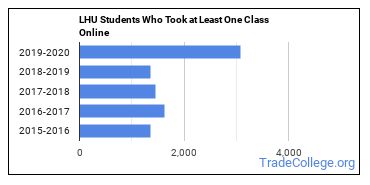Lock Haven University Trade Programs
Located in Lock Haven, Pennsylvania, Lock Haven University is a public institution. The charming, small-town atmosphere of Lock Haven draws many to the area.
Featured schools near , edit
Awards From Around the Web
The following table lists some notable awards LHU has earned from around the web.
| Rank | Ranking Name | Source |
|---|---|---|
| #27 | Highest Paid Athletic Training Graduates | College Factual |
| #39 | Best Value Colleges for Athletic Training | College Factual |
| #74 | Best Nursing Associate Degree Schools | Nursing Degree Search |
| #169 | Highest Paid Allied Health Professions Graduates | College Factual |
Where Is Lock Haven University?

Contact details for LHU are given below.
| Contact Details | |
|---|---|
| Address: | 401 North Fairview Street, Lock Haven, PA 17745-2390 |
| Phone: | 570-484-2011 |
| Website: | www.lockhaven.edu |
| Facebook: | https://www.facebook.com/LockHavenUniversityofPA?ref=hl |
| Twitter: | https://twitter.com/LockHavenUniv |
Can I Afford LHU?
| In State | Out of State | |
|---|---|---|
| Tuition | $7,716 | $17,290 |
| Fees | $3,162 | $3,412 |
| Books and Supplies | $1,830 | $1,830 |
| On Campus Room and Board | $10,350 | $10,350 |
| On Campus Other Expenses | $4,564 | $4,564 |
Student Loan Debt
It's not uncommon for college students to take out loans to pay for school. In fact, almost 66% of students nationwide depend at least partially on loans. At LHU, approximately 82% of students took out student loans averaging $9,290 a year. That adds up to $37,160 over four years for those students.
The student loan default rate at LHU is 7.6%. Although this is lower than the national default rate of 10.1%, you'll still want to keep this in mind when taking out student loans.
Lock Haven University Undergraduate Student Diversity

There are also 436 graduate students at the school.
Gender Diversity
Of the 2,311 full-time undergraduates at LHU, 40% are male and 60% are female.

Racial-Ethnic Diversity
The racial-ethnic breakdown of Lock Haven University students is as follows.

| Race/Ethnicity | Number of Grads |
|---|---|
| Asian | 24 |
| Black or African American | 156 |
| Hispanic or Latino | 81 |
| White | 1,978 |
| International Students | 10 |
| Other Races/Ethnicities | 62 |
Geographic Diversity
Pennsylvania students aren't the only ones who study at Lock Haven University. At this time, 12 states are represented by the student population at the school.
Over 16 countries are represented at LHU. The most popular countries sending students to the school are Kenya, China, and Trinidad and Tobago.
Online Learning at Lock Haven University
The following chart shows how the online learning population at LHU has changed over the last few years.

Online Growth Rankings of LHU
The average growth rate over the last four years of online students at Lock Haven University was 94.4%. This is the #360 largest growth rate of all schools that are mostly online. This refers to all students at LHU regardless of major.
When we speak of partially online, we are referring to schools whose online population is less than 50% of its total student body. Mostly online refers to those with online populations greater than or equal to 50%.
Lock Haven University Trade School Concentrations
The table below shows the number of awards for each concentration.
| Major | TOTAL |
|---|---|
| Nanotechnology | 0 |
| Athletic Training | 0 |
| TOTAL | 0 |
References
*The racial-ethnic minorities count is calculated by taking the total number of students and subtracting white students, international students, and students whose race/ethnicity was unknown. This number is then divided by the total number of students at the school to obtain the racial-ethnic minorities percentage.
- College Factual
- National Center for Education Statistics
- Image Credit: By Ruhrfisch under License
More about our data sources and methodologies.
Featured Schools
 Request Info
Request Info
|
Southern New Hampshire University You have goals. Southern New Hampshire University can help you get there. Whether you need a bachelor's degree to get into a career or want a master's degree to move up in your current career, SNHU has an online program for you. Find your degree from over 200 online programs. Learn More > |
